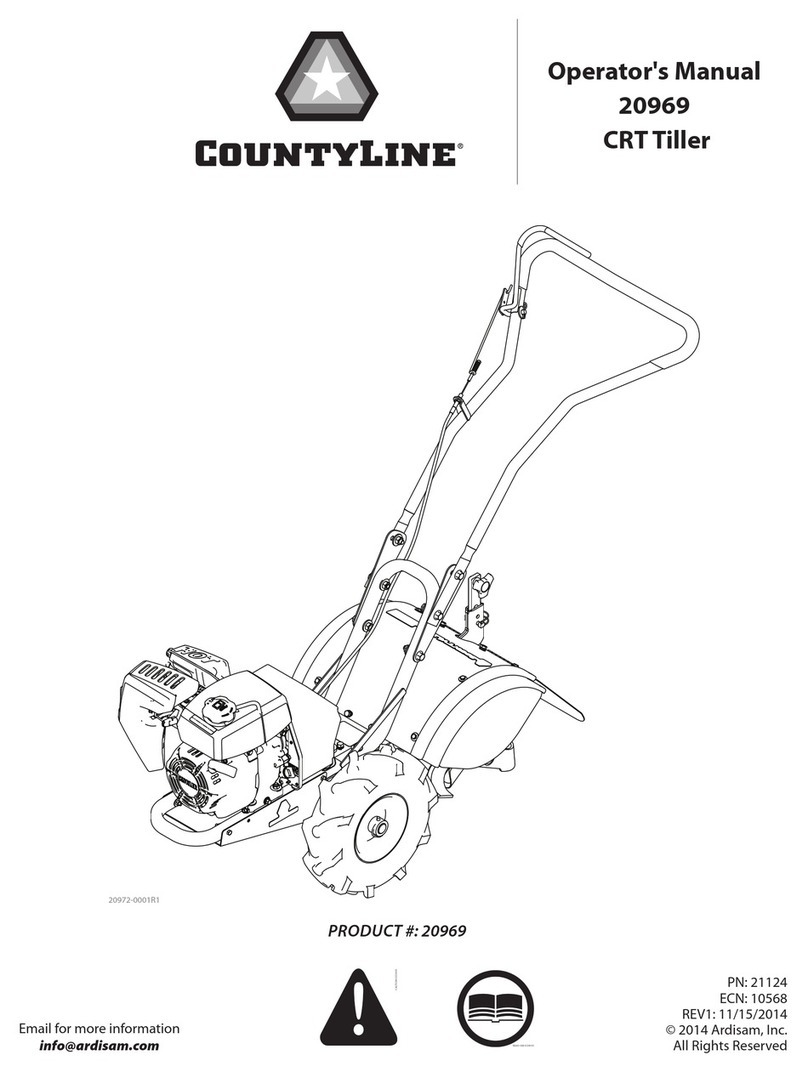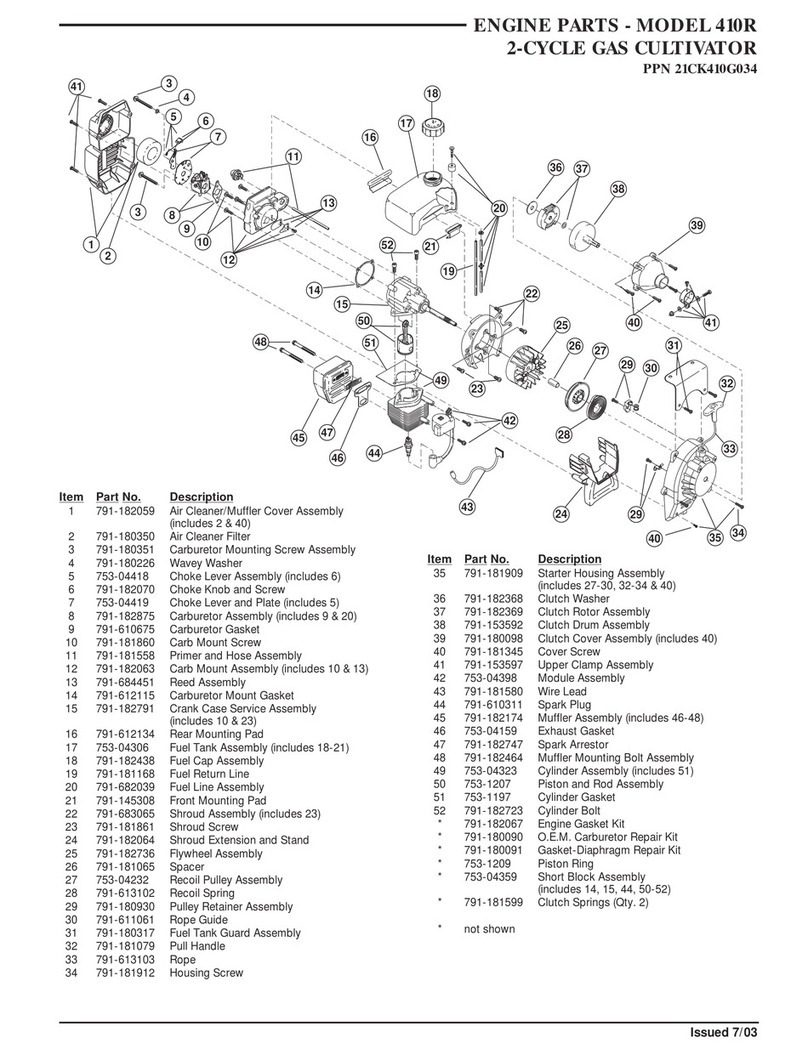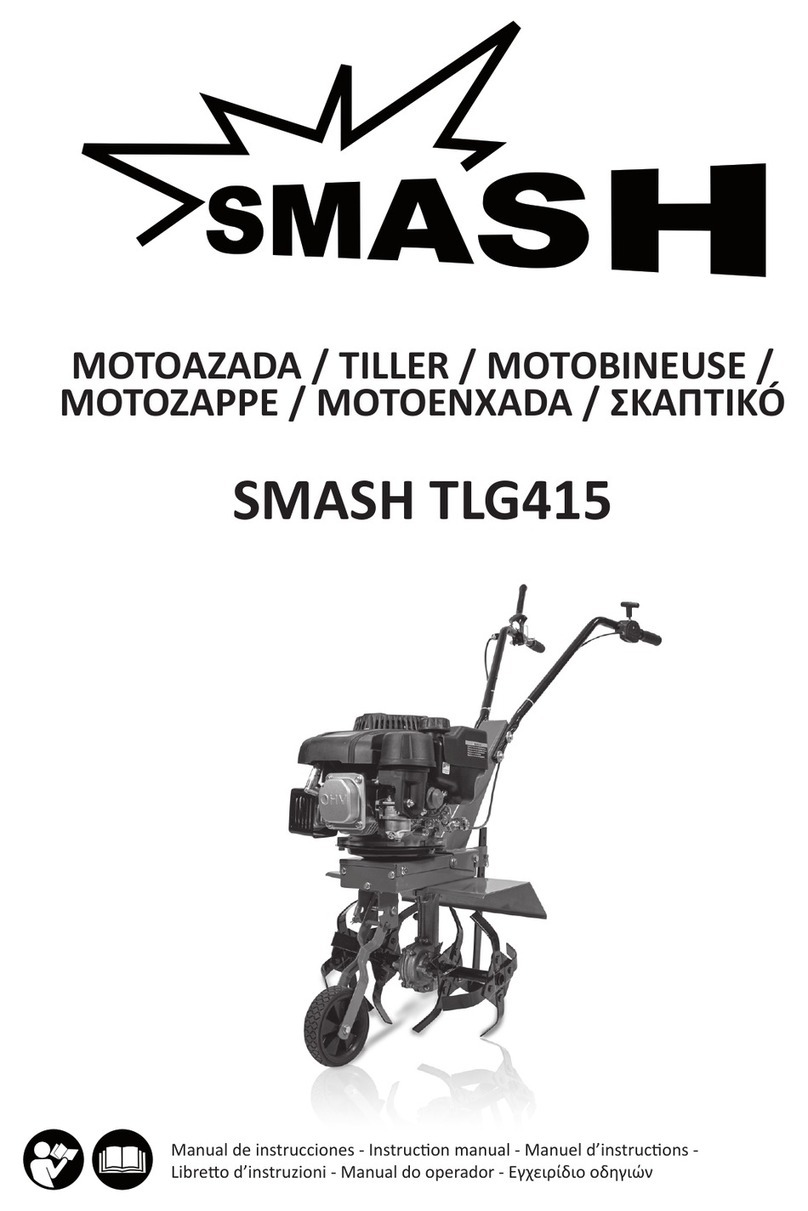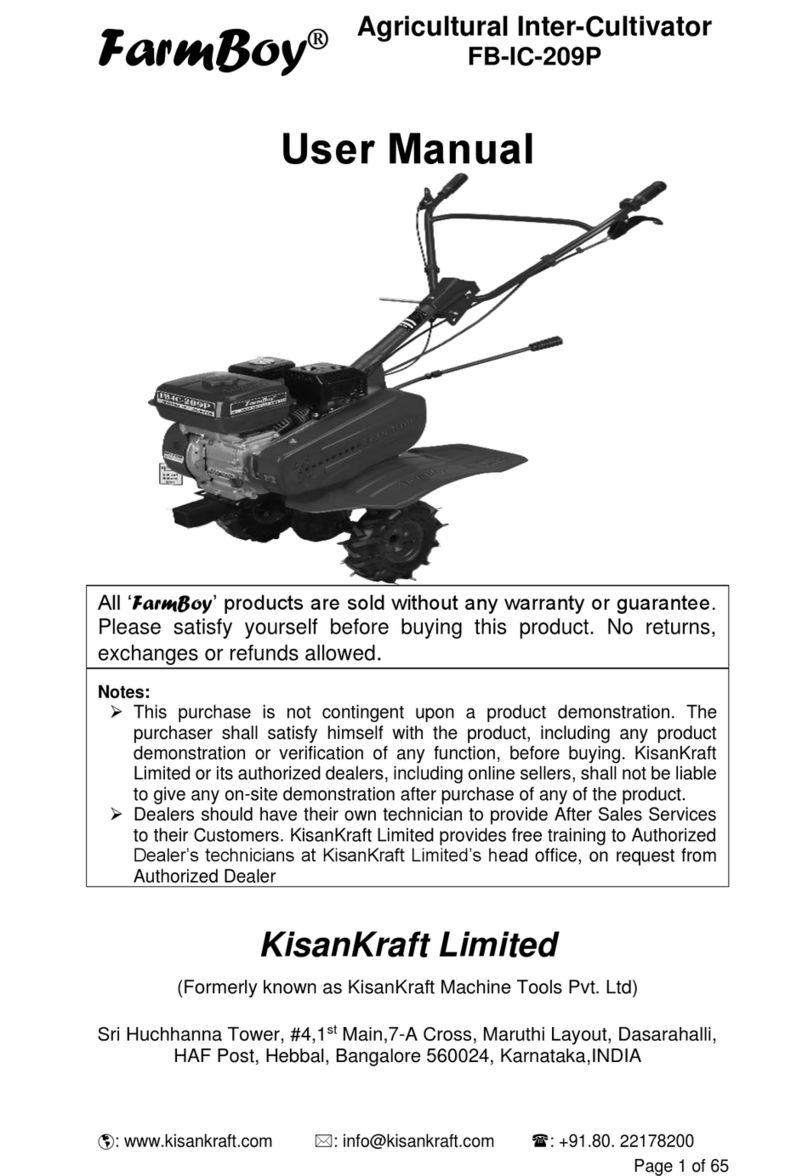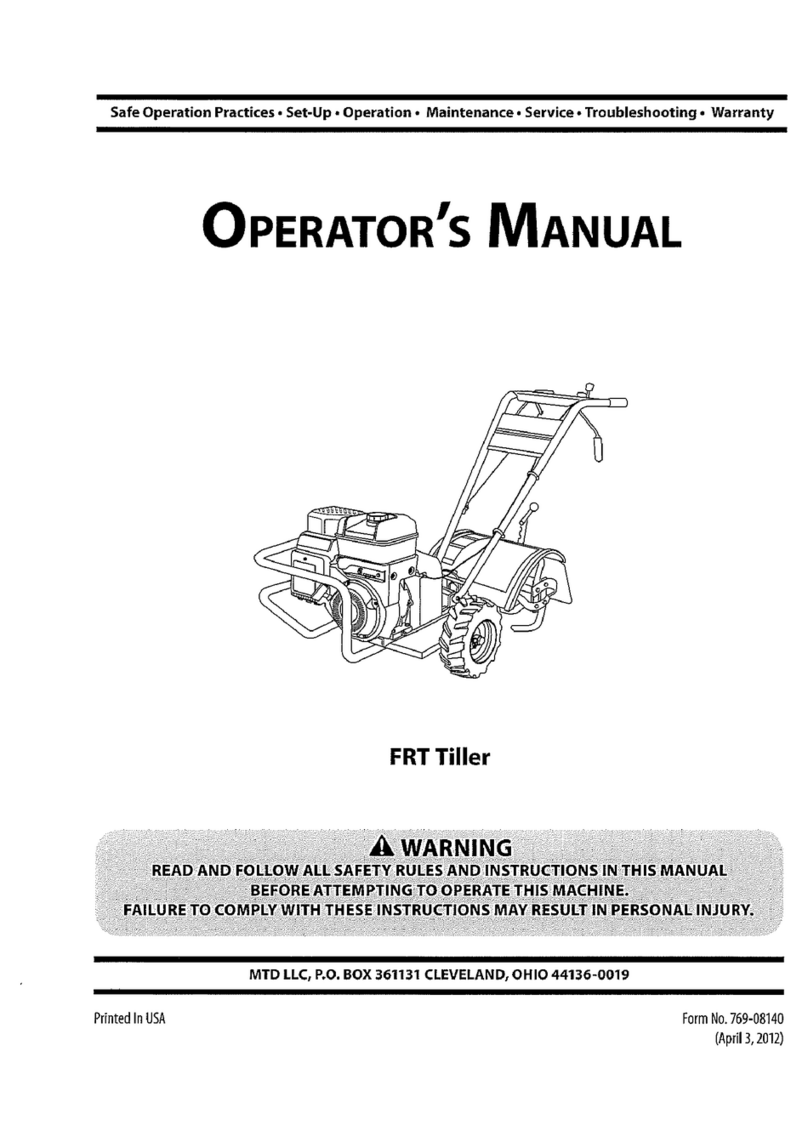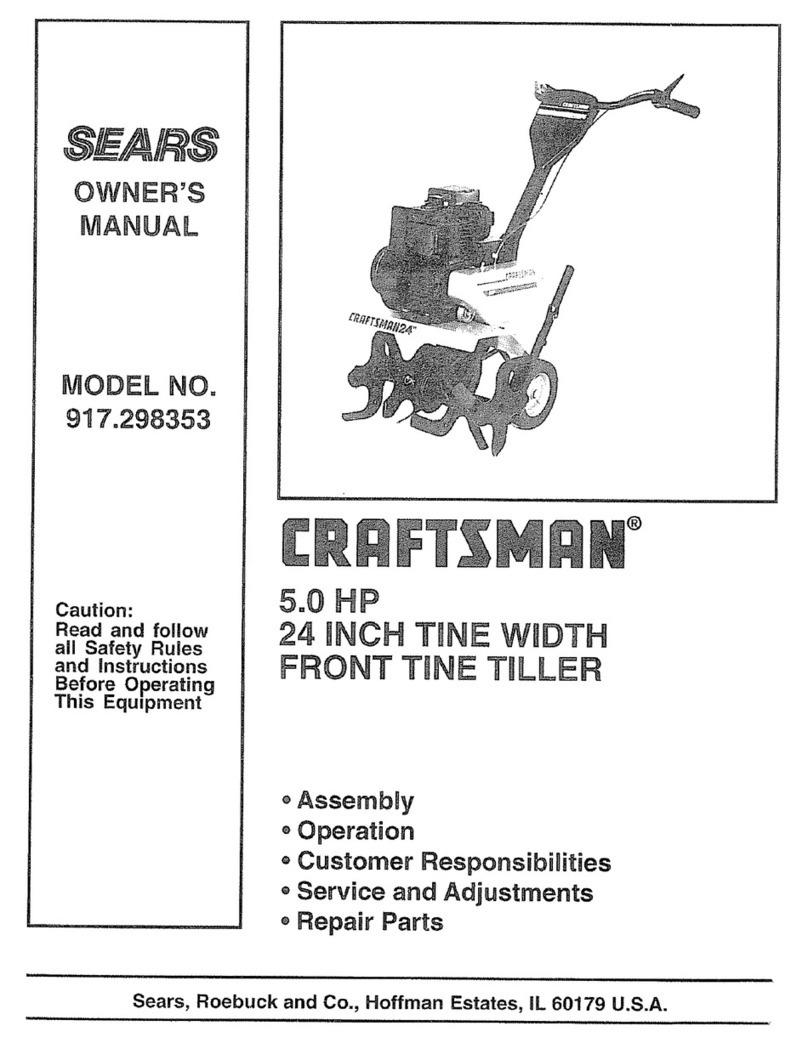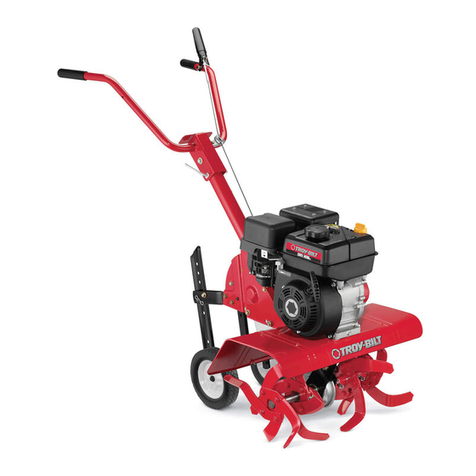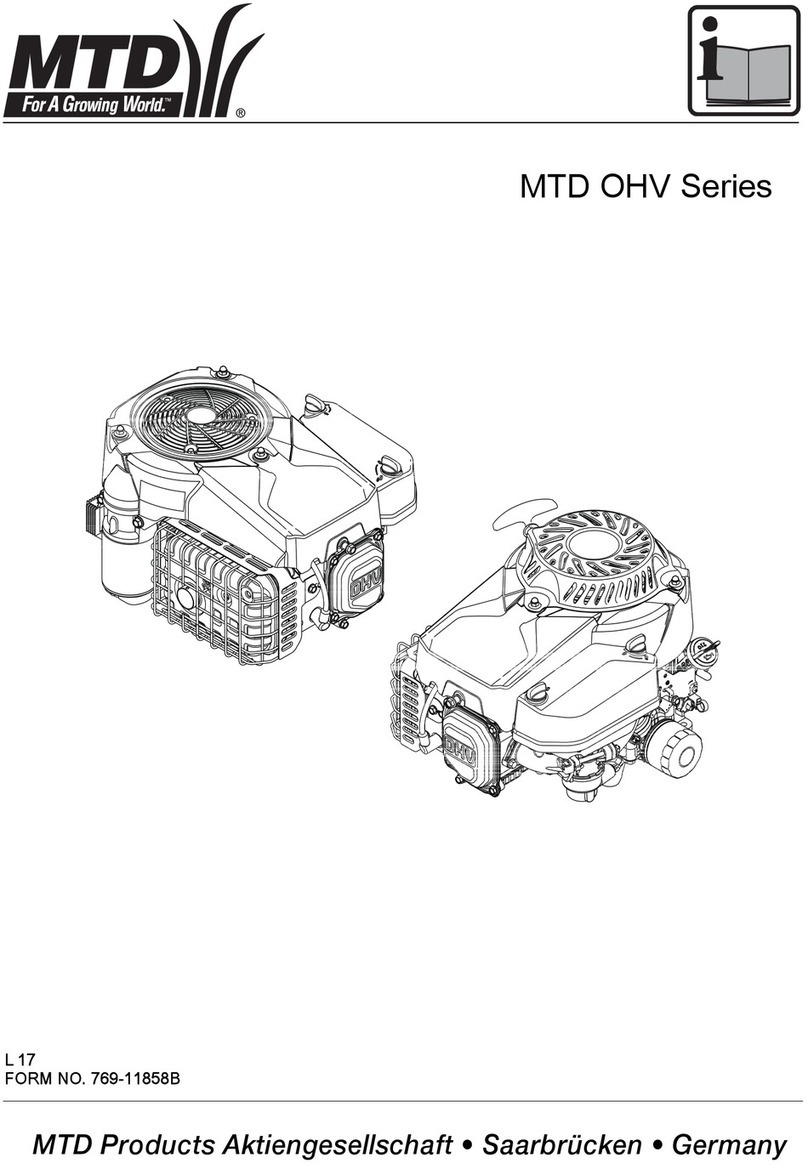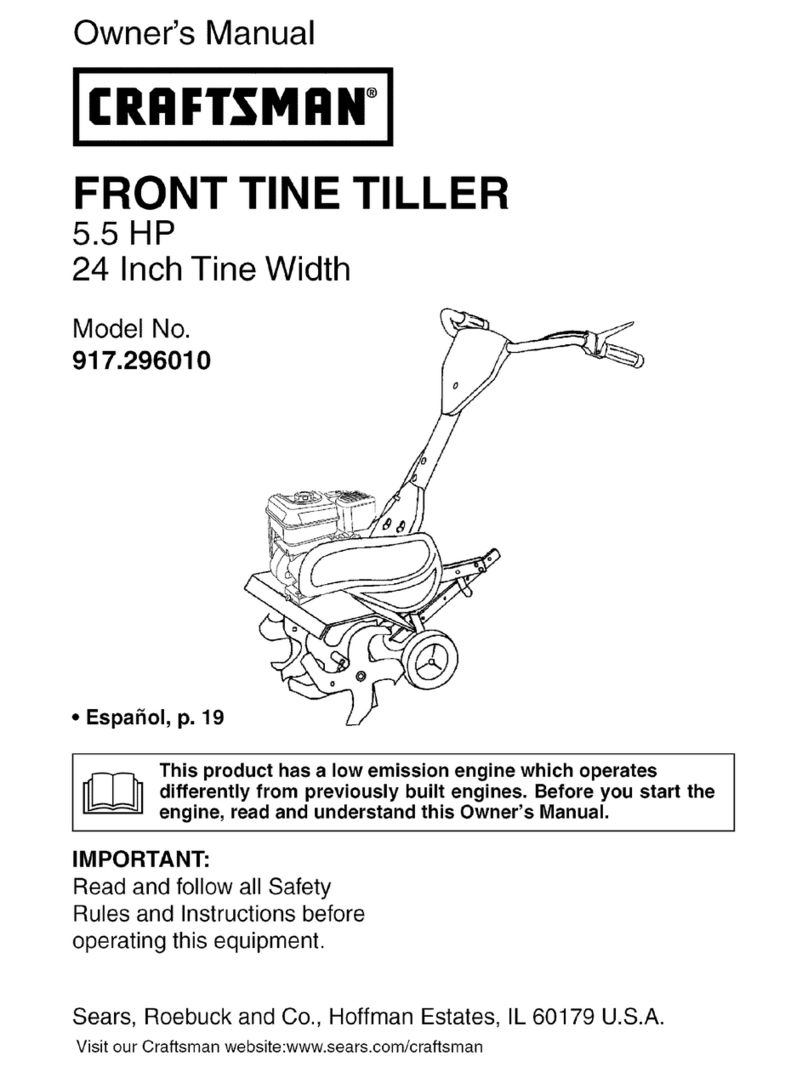CountyLine 17455 User manual

Email for more information
GAS/OIL
RATIO
50:1
Operator's Manual
Original Operating Instructions
17455
Front Tine Tiller
P/N: 17460
ECN: 10117
REV1: 09/04/13
© 2014 Ardisam, Inc.
All Rights Reserved.
Model 17455
Briggs & Stratton
6.75 ft-lbs Gross Torque

2
Operator’s Manual
17455 Front Tine Tiller
INTRODUCTION
Thank you for purchasing the 17455 Tiller from CountyLine®. We have worked to ensure that this tiller meets the highest standards
for usability and durability. With proper care, your tiller will provide many years of service.
Please read this entire manual before installation and use. CountyLine reserves the right to change, alter or improve the
product and this document at any time without prior notice.
CONTENTS
Introduction .......................................................................................................................................................................................................................................2
Warnings and Safety Precautions...........................................................................................................................................................................................3-8
Unpacking and Assembly .........................................................................................................................................................................................................8-9
Features .............................................................................................................................................................................................................................................10
Controls.......................................................................................................................................................................................................................................11-12
Operation...................................................................................................................................................................................................................................12-13
Maintenance .............................................................................................................................................................................................................................14-16
Storage...............................................................................................................................................................................................................................................17
Troubleshooting and Repair.......................................................................................................................................................................................................18
Warranty ............................................................................................................................................................................................................................................19
Parts Breakdown......................................................................................................................................................................................................................20-23
REGISTRATION AND SERVICE
OWNERSHIP RECORDS
Owner’s Name:
Owner’s Address:
City: State/Province: Zip Code/Postal Code:
Model Number: Serial Number:
Date of Purchase:
Notes:
Record the product model number and serial number in the space provided for easy reference when ordering parts or requesting
technical support. Excluding emissions-related warranty items, the warranty is valid only if the completed registration is received
by Ardisam within 30 days of purchase. (SEE WARRANTY SECTION FOR MORE INFORMATION) You can register your warranty by
mailing it to: Ardisam Inc, 1160 Eighth Avenue, Cumberland, WI 54829. You may also call our customer service department at (800)
345-6007 Mondays through Fridays from 8 a.m. to 5 p.m. CST.
Read and keep this manual for future reference. This manual contains important information on SAFETY, ASSEMBLY, OPERA-
TION, AND MAINTENANCE. The owner must be certain that all the product information is included with the unit. This infor-
mation includes the MANUAL, the REPLACEMENT PARTS and the WARRANTIES. This information must be included to make
sure state laws and other laws are followed. All persons to whom rent/loan this unit must have access to and understand this
information. This manual should remain with the product even if it is resold.

Operator’s Manual
17455 Front Tine Tiller
DANGER
DANGER INDICATES A SERIOUS INJURY OR FATALITY
WILL RESULT IF THE SAFETY INSTRUCTIONS THAT
FOLLOW THIS SIGNAL WORD ARE NOT OBEYED.
WARNING
WARNING INDICATES A SERIOUS INJURY OR FATALITY
COULD RESULT IF THE SAFETY INSTRUCTIONS THAT
FOLLOW THIS SIGNAL WORD ARE NOT OBEYED.
CAUTION
CAUTION INDICATES YOU CAN OR YOUR EQUIPMENT
CAN BE HURT IF THE SAFETY INSTRUCTIONS THAT
FOLLOW THIS SIGNAL WORD ARE NOT OBEYED.
IMPORTANT
IMPORTANT INDICATES HELPFUL INFORMATION FOR
PROPER ASSEMBLY, OPERATION, OR MAINTENANCE
OF YOUR EQUIPMENT.
WARNING
YOU MUST READ, UNDERSTAND AND COMPLY WITH
ALL SAFETY AND OPERATING INSTRUCTIONS IN
THIS MANUAL BEFORE ATTEMPTING TO SETUP AND
OPERATE YOUR ROTOTILLER.
FAILURE TO COMPLY WITH ALL SAFETY AND
OPERATING INSTRUCTIONS CAN RESULT IN LOSS OF
MACHINE CONTROL, SERIOUS PERSONAL INJURY TO
YOU AND/OR BYSTANDERS, AND RISK OF EQUIPMENT
AND PROPERTY DAMAGE. THE TRIANGLE IN THE TEXT
SIGNIFIES IMPORTANT CAUTIONS OR WARNINGS
WHICH MUST BE FOLLOWED.
CALIFORNIA PROPOSITION 65 WARNING
ENGINE EXHAUST FROM THIS PRODUCT CONTAINS
CHEMICALS KNOWN TO THE STATE OF CALIFORNIA
TO CAUSE CANCER, BIRTH DEFECTS, OR OTHER
REPRODUCTIVE HARM.
SRT CRT
DANGER
WARNINGS AND SAFETY PRECAUTIONS
OWNER’S RESPONSIBILITY
Accurate assembly and safe and eective use of the rototiller is
the owner’s responsibility.
• Readandfollowallsafetyinstructions.
• Carefullyfollowallassemblyinstructions.
• Maintainthetilleraccordingtodirectionsandschedule
included in this CountyLine operator’s manual.
• Ensurethatanyonewhousesthetillerisfamiliarwithall
controls and safety precautions.
SPECIAL MESSAGES
Your manual contains special messages to bring attention to
potential safety concerns, machine damage as well as helpful
operating and servicing information. Please read all the informa-
tion carefully to avoid injury and machine damage.
NOTE: General information is given throughout the manual
that may help the operator in the operation or service of
the machine.
IMPORTANT SAFETY PRECAUTIONS
Please read this section carefully. Operate the tiller according
to the safety instructions and recommendations outlined here
and inserted throughout the text. Anyone who uses this tiller
must read the instructions and be familiar with the controls.
Your tiller is equipped with a safety device that enables you to
stop the wheels and tines quickly in an emergency. Learn how
the drive safety control lever operates and how to control the
tiller at all times.
This symbol points out important safety instructions
which if not followed could endanger your personal
safety. Read and follow all instructions in this man-
ual before attempting to operate this equipment.
• Donotallowchildrentooperatethisrototiller.Keepsmallchildren
away from the area being tilled. Do not allow adults to operate the
tiller without proper instruction.
Intended Use / Foreseeable Misuse
IMPORTANT: This is a motorized rotary tiller that works the
soil by means of rotating tines. It is pedestrian-controlled, but
not self-propelled, with a gasoline-fueled internal combustion
engine to power the tines. It shall not be used for any other
purpose.

4
Operator’s Manual
17455 Front Tine Tiller
GENERAL SAFETY RULES
• Read, understand, and follow all instructions on the machine
and in the manual(s). Be thoroughly familiar with the controls
and the proper use of the machine before starting.
• Use this equipment for its intended purpose only.
• Familiarize yourself with all of the safety and operating
decals on this equipment and on any of its attachments or
accessories.
• Do not put hands or feet near or under rotating parts.
• Only allow responsible individuals who are familiar with the
instructions to operate the machine. Do not allow children
to operate this machine. Do not allow adults to operate the
machine without proper instruction.
• Thoroughly inspect the area where the machine is to be
used and remove all foreign objects. Your equipment can
propel small objects at high speed causing personal injury
or property damage. Stay away from breakable objects, such
as house windows, automobiles, greenhouses, etc.
• Wear appropriate clothing such as a long-sleeved shirt or
jacket. Also wear long trousers or slacks. Do not wear shorts.
Never wear sandals, sneakers or open shoes, and never
operate the machine with bare feet.
• Do not wear loose clothing or jewelry. They can get caught in
moving parts. Always keep hands, feet, hair and loose clothing
away from any moving parts on engine and machine.
• Always wear safety goggles or safety glasses with side shields
when operating the machine to protect your eyes from
foreign objects which can be thrown from the unit. Always
wear a protective hearing device.
• Always wear work gloves and sturdy footwear. Wear
footwear that will improve footing on slippery surfaces.
Leather work shoes or short boots work well for most people.
These will protect the operator’s ankles and shins from small
sticks, splinters, and other debris.
• It is advisable to wear protective headgear to prevent the
possibility of being struck by small ying particles, or being
struck by low hanging branches, twigs, or other objects
which may be unnoticed by the operator.
• Do not operate the machine without proper guards or other
safety protective devices in place.
• See manufacturer’s instructions for proper operation and
installation of accessories. Only use accessories approved
by the manufacturer.
• Operate only in daylight or good articial light.
• Do not operate product when fatigued or under the
influence of alcohol, drugs or other medication which
can cause drowsiness or aect your ability to operate this
machine safely.
• Never operate machine in wet grass. Always be sure of your
footing; keep a rm hold on the handle and walk; never run.
• Watch for trac when operating machine near, or when
crossing roads.
• If the equipment should start to vibrate abnormally, stop the
engine (motor), ip the ON/OFF switch to the OFF position.
Check immediately for cause.Vibration is generally a warning
of trouble. If the noise or vibrations of the machine increase,
stop immediately and perform an inspection.
• Never leave the machine unattended when the engine is
running. Flip the ON/OFF switch to the OFF position.
• Regularly inspect the machine. Make sure parts are not bent,
damaged or loose.
• Temperature of muer and nearby areas may exceed 150°
F (65° C). Allow muer and engine areas to cool before
touching. Never pick up or carry the machine while the
engine is running.
• Prolongedexposuretonoise andvibrationfromgasolineengine-
powered equipment should be avoided. Take intermittent
breaks and/or wear ear protection from engine noise as well as
heavy work gloves to reduce vibration in the hands.
• Keepallscrews,nutsandboltstight.
• Do not transport the machine from one place to another
with the engine running.
• When moving the packaged machine, always do so with a
partner.
• Check local regulations for age restrictions on use of this
machine.
PRODUCTSPECIFIC SAFETY RULES
• Do not till above underground utilities, including water
lines, gas lines, electric cables, or pipes. Do not operate the
machine on terrain/soil with large rocks and foreign objects
which can damage the equipment.
• After striking a foreign object, stop the engine. Flip the ON/
OFF switch to the OFF position. Inspect the machine for
damage. If damaged, repair before starting and operating
the machine.
• The tines of the tiller should not rotate when the drive control
lever is released into the neutral position. If it does rotate
when in neutral, contact CountyLine customer service for
instruction.
• If an object becomes lodged in the tines, ip the ON/OFF
switch to the OFF position, allow to cool before attempting
to remove the foreign object.
• Pulleys and belts should be kept free of oil or other moisture
for ecient operation.
• Disengage all clutches and leave control lever in the neutral
position before starting the engine.

Operator’s Manual
17455 Front Tine Tiller
CAUTION
HOT GASES ARE A NORMAL BYPRODUCT OF A FUNC
TIONING INTERNAL COMBUSTION ENGINE. FOLLOW
ALL SAFETY INSTRUCTIONS TO PREVENT BURNS AND
FIRES.
DO NOT ALTER/MODIFY ENGINE:
NEVER ALTER OR MODIFY THE ENGINE FROM THE
FACTORY. SERIOUS INJURY OR DEATH MAY OCCUR IF
ENGINE IS MODIFIED OR ALTERED.
WHEN WORKING ON OR REPLACING PARTS FOR THE
ENGINE OR PRODUCT, YOU MUST ALWAYS FLIP THE
ON/OFF SWITCH TO THE OFF POSITION.
ENGINE SAFETY PRECAUTIONS
Warning Carbon Monoxide Poisoning
Engines give off carbon monoxide, an odorless, colorless,
poisonous gas. Carbon monoxide may be present even if you do
notsmell orsee any engine exhaust. Breathing carbonmonoxide
can cause nausea, fainting or death, in addition to drowsiness,
dizziness and confusion. If you experience any of these
symptoms, seek fresh air and medical attention immediately.
If your product comes with a separate engine manual, be
sure to read and follow all safety and warning precautions
outlined there, in addition to any in this manual.
Preventing Carbon Monoxide Poisoning
• Always start and run engine outdoors. Do not start or run
engine in an enclosed area, even if doors or windows are open.
• Never try to ventilate engine exhaust indoors. Carbon
monoxide can reach dangerous levels very quickly.
• Never run engine outdoors where exhaust fumes may be
pulled into a building.
• Never run engine outdoors in a poorly ventilated area where
the exhaust fumes may be trapped and not easily taken
away. (Examples include: in a large hole or areas where hills
surround your working area.)
• Never run engine in an enclosed or partially enclosed area.
(Examples include: buildings that are enclosed on one or
more sides, under tents, car ports or basements.)
• Always run the engine with the exhaust and muer pointed
in the direction away from the operator.
• Never point the exhaust muer towards anyone. People
should always be many feet away from the operation of the
engine and its attachments.
• Do not change the engine governor settings or over-speed
the engine.
WARNING
ENGINES GIVE OFF CARBON MONOXIDE, AN ODOR
LESS, COLORLESS, POISONOUS GAS. CARBON MON
OXIDE MAY BE PRESENT EVEN IF YOU DO NOT SMELL
OR SEE ANY ENGINE EXHAUST. BREATHING CAR
BON MONOXIDE CAN CAUSE NAUSEA, FAINTING OR
DEATH, IN ADDITION TO DROWSINESS, DIZZINESS
AND CONFUSION.
IF YOU EXPERIENCE ANY OF THESE SYMPTOMS, SEEK
FRESH AIR AND MEDICAL ATTENTION IMMEDIATELY.
Gasoline Fires and Handling Fuel Safely
Use extra care in handling gasoline and other fuels. They are
ammable and vapors are explosive.
• When storing extra fuel be sure that it is in an appropriate
container and away from any re hazards.
• Prevent re and explosion caused by static electric discharge.
Use only nonmetal, portable fuel containers approved by the
Underwriter’s Laboratory (U.L.) or the American Society for
Testing & Materials (ASTM).
• Always ll fuel tank outside in a well ventilated area. Never
fill your fuel tank with fuel indoors. (Examples include:
basement, garage, barn, shed, house, porch, etc.) Never
ll tank near appliances with pilot lights, heaters, or other
ignition sources. If the fuel has to be drained, this should
be done outdoors. The drained fuel should be stored in a
container specically designed for fuel storage or it should
be disposed of carefully.
• Never remove the fuel cap or add fuel with the engine
running. Stop engine and allow to cool before lling.
• Do not smoke.
• Never drain fuel from engine in an enclosed area.
• Always wipe up excess (spilled) fuel from engine before
starting. Clean up spilled fuel immediately. If fuel is spilled,
do not start the engine but move product and fuel container
from area. Clean up spilled fuel and allow to evaporate and
dry after wiping and before starting.
• Allow fuel fumes/vapors to escape from the area before
starting engine.
• Test the fuel cap for proper installation before starting and
using engine.
• Always run the engine with fuel cap properly installed on
the engine.
• Never smoke while relling engine fuel tank.
• Do not store engine with fuel in fuel tank indoors. Fuel and
fuel vapors are highly explosive.
Table of contents
Other CountyLine Tiller manuals
Popular Tiller manuals by other brands
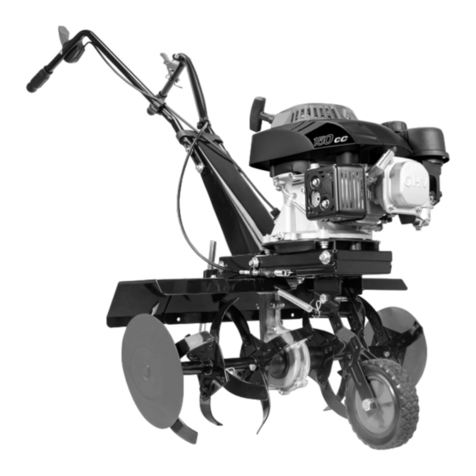
Scheppach
Scheppach MTP560 Translation from the original instruction manual
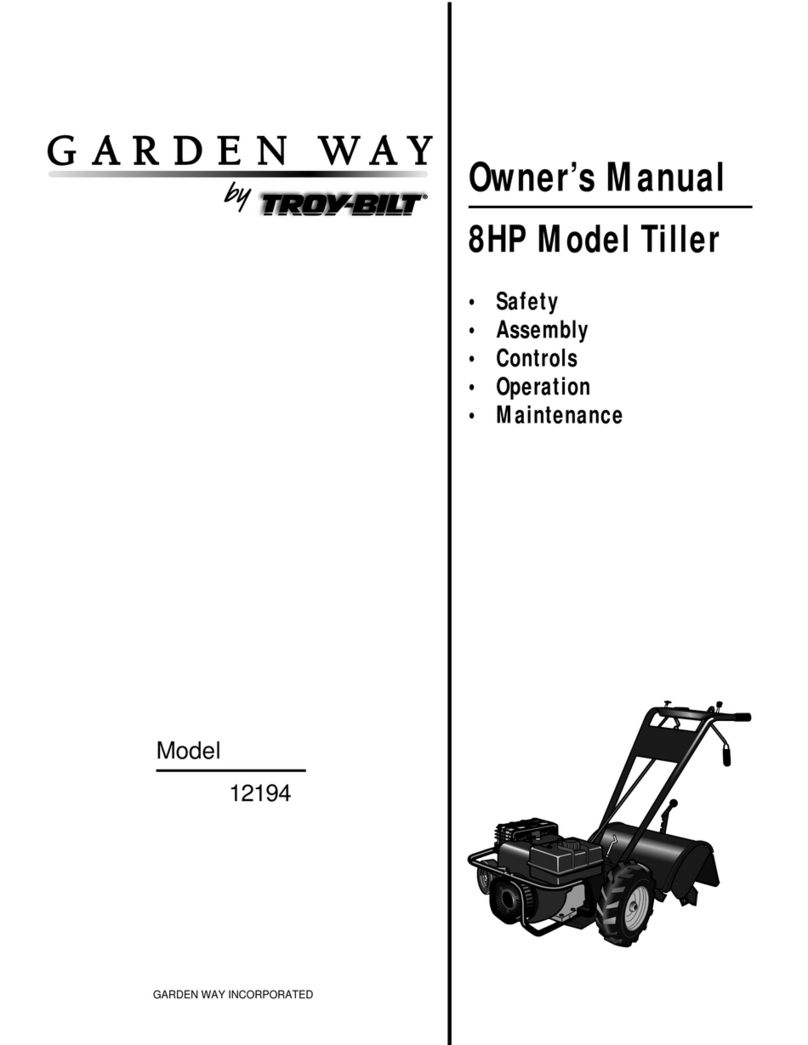
GARDEN WAY
GARDEN WAY 12194 owner's manual
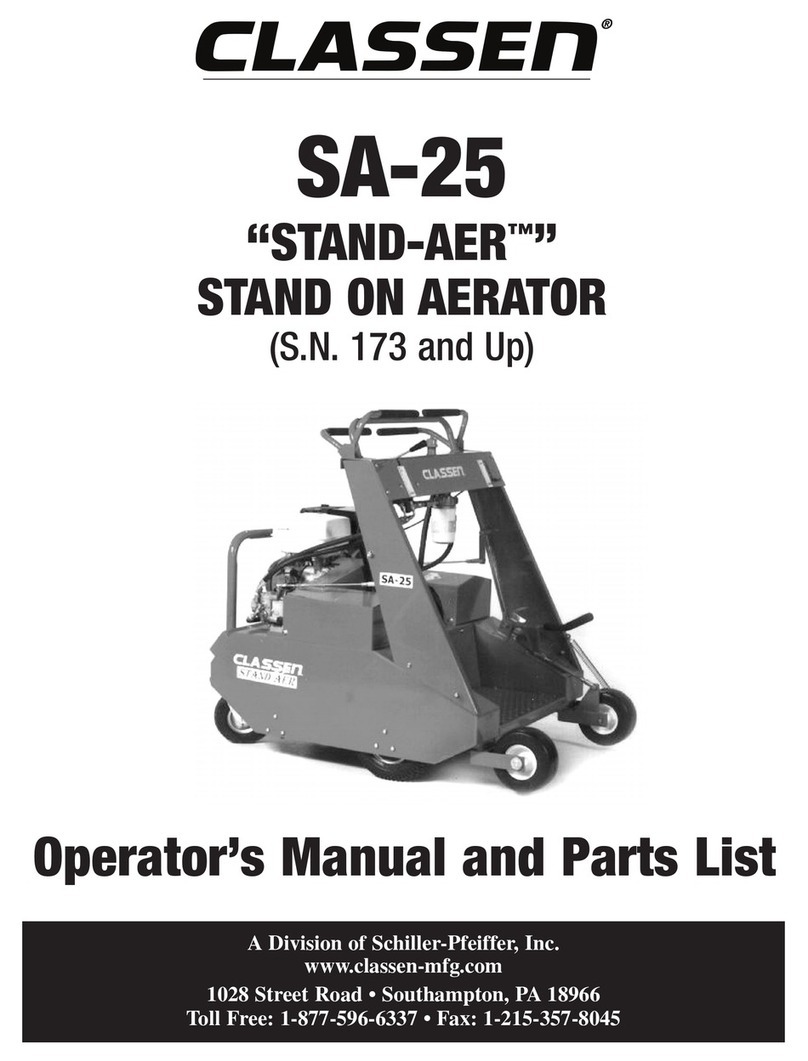
Classen
Classen STAND-AER SA-25 Operator's manual and parts list

Altrad
Altrad ATIKA BH 1400 N Original instructions, safety instructions, spare parts

DR
DR PILOT 2 Safety & Operating Instructions

AL-KO
AL-KO TL 1820 Instructions for use
